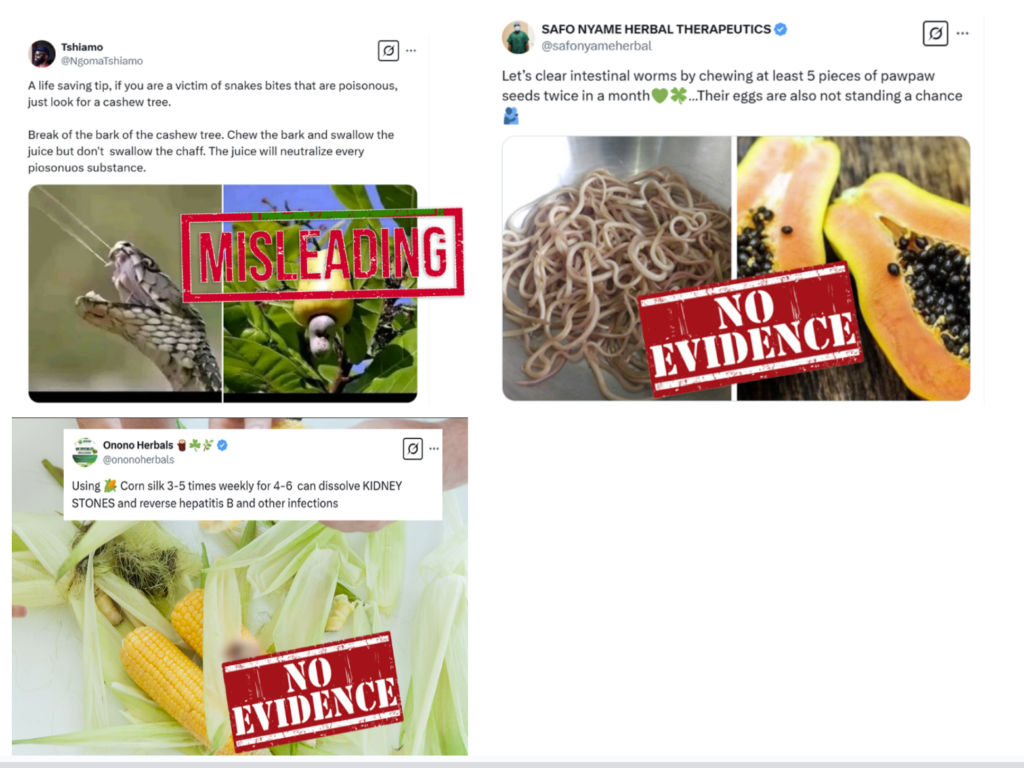Tackling The Spread of Health Misinformation On Social Media

Accurate health information is important as people rely on such information to make decisions about their well-being, such as whether to see a doctor, take medication, or change their diet. This helps people detect ailment early, go for proper medical consultation and treatment, and work towards managing their health conditions.
The rise of social media as a source of health information has dramatically transformed how people access and engage with health-related content. Platforms like Instagram, TikTok, YouTube, Twitter (X), and Facebook allow health content to reach millions instantly, thereby allowing people from different regions share personal experiences, alternative remedies, and cultural approaches to health. A look through the several health claims fact-checked by NV-A shows how misleading health advice can make people take unsafe actions like using unproven treatments, delay proper medical care, or ignore verified professional guidance.
Causes and Spread of Fake Health Advice
In 2003, a rumour that the oral polio vaccine contained porcine material and sterilising agents led to a boycott of polio vaccination in Northern Nigeria. Following this vaccine boycott, an upsurge in polio cases resulted in wild polio re-infection in several countries across Africa and Asia. Rumours also broke out in Nigeria in late 2017, purporting that the Nigerian military was vaccinating school children with the monkeypox virus.
Misinformation during health crises, especially during outbreaks including the COVID-19 pandemic were widespread and had serious consequences. Some claimed the pandemic was fabricated or exaggerated for political or economic gain, despite global scientific consensus and overwhelming evidence.
Confounding this infodemic are social media influencers. These are individuals with large or highly engaged followings on platforms like Instagram, TikTok, YouTube, or X (formerly Twitter). Although they are not health professionals, they often comment on health, wellness, and lifestyle, and these influencers are more trusted than professional experts due to perceived authenticity and personal connection. It is also noted that people who lack digital literacy often struggle to distinguish between credible sources, like medical journals or official health organisations, and unreliable ones like random blogs or social media influencers. This makes them more likely to trust and share health-related misinformation from these influencers.
Consequences of Fake Health Information
On social media, emotional or sensational content spreads more quickly than verified medical advice. When someone reads fake health information like “some oils, being a cure to cancer” or “vaccines cause infertility,” they tend to believe it and make choices based on these misleading posts. In 2022, Plushcare analysed 500 TikTok videos with the hashtag #mentalhealth or #mentalhealthtips and found that more than 80 percent of the content under the tags were misleading.
Two people died and at least twenty were hospitalised, due to a social media prank urging Nigerians to drink excessive amounts of salt water to avoid catching the Ebola virus that was in 2014. Unverified sources or influencers with their engaging post format spread harmful or dangerous practices on social media, misleads people into believing that certain unsafe behaviours are beneficial and necessary for their health. When people are exposed to false or misleading health claims, especially if they contradict what professionals are saying, they may begin to question the expertise and motives of doctors, scientists, and health organisations. In certain cases, some of the health misinformation aligns more closely with their own personal views, hence they consider science and health experts as untrustworthy or even corrupt.
Current Efforts to Address the Issue
The absence of clear and standardised oversight for misinformation on social platforms leaves users to shoulder the burden of distinguishing truth from falsehood. Although, fact-checking platforms are working round the clock to address the spread of fake health information. These fact-checkers are identifying and correcting claims, such as fake cures and misleading health information about diseases, by pointing out inaccuracies and using evidence-based knowledge and research about health topics to debunk health misinformation.
Organisations like the World Health Organisation, WHO, and the Nigeria Centre for Disease Control and Prevention, NCDC, are now running public campaigns to educate people on how to identify trustworthy sources of health information. Public awareness campaigns are one of the most effective tools for combating fake health information on social media. It teaches people how to distinguish between credible health information and misinformation, promotes media literacy, encourages users to question sources and cross-check facts before sharing. Campaigns can be tailored to specific groups (e.g., young adults, parents, elderly) who are more likely to encounter or spread misinformation.
More importantly, governments and legislators have to make policies that can create or enforce laws that penalise the spread of harmful misinformation, as well as require social media companies to implement content moderation practices, such as partnering with fact-checking organisations. Also, strengthening collaboration between tech platforms and health experts is a crucial strategy to curb the spread of fake health advice because it combines the reach and influence of digital platforms with the credibility and expertise of health professionals.
Conclusion
Health misinformation does not just mislead, it harms. Improving digital and health literacy among users is a powerful strategy to curb the spread of fake health advice because it empowers people to recognise, question, and reject misinformation. They will be better at recognising reputable websites and unreliable ones. People should be better equipped to know how to look for signs of manipulation, like altered images or fake profiles on their social media timelines.
Reliable creators such as licensed medical professionals and public health institutions that have built their credibility over time should be platformed more. When the public trusts a source, they are more likely to follow their advice and less likely to fall for misinformation. When social media platforms push the content of these trusted voices, it reaches a wider audience and puts the right information at users’ tip. This helps ensure that accurate, evidence-based health information is more likely to be seen than misleading or dangerous content.





